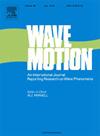Evolutionary equations of a sharing-bicycle system and their solutions
IF 2.1
3区 物理与天体物理
Q2 ACOUSTICS
引用次数: 0
Abstract
The development of sharing-bicycle systems is accompanied by serious phenomena such as indiscriminate parking of shared bikes. This study aims to explore causes of parking behaviour problems in a sharing-bicycle system. Based on user demand and the characteristics of the shared bicycle system, we establish the evolutionary equations for the two variables, the density of user groups on the road, and the density of parked shared bicycles on the road, and study conditions satisfied by a shock wave solution. The results of the model’s shock wave solution, time-invariant solution, and travelling wave solution allow us to reveal the phenomenon of aggregation of sharing-bicycles on the sidewalk due to the architecture of a sharing-bicycle system, as well as the fluctuation of the variables that still exists in a stable system. The results have a wide range of potential impacts on sharing-bicycle system operators. In terms of operation strategy, operators can predict the gathering situation of sharing-bicycle system at different times and places according to our model, so as to optimize vehicle scheduling and parking management and reduce the phenomenon of disorderly parking. In addition, in terms of cost control, operators can use resources more effectively and reduce operating costs through more accurate forecasting and scheduling. Our research findings, when combined the basic technologies of modern sharing-bicycle system (such as mobile payment and location technology), promise to significantly enhance system optimization, control, and management, thereby fostering the sustainable growth of the sharing-bicycle industry.
共享单车系统的演化方程及其解
共享单车系统的发展伴随着共享单车乱停放等严重现象。本研究旨在探讨共享单车系统中停车行为问题的成因。基于用户需求和共享单车系统的特点,建立了道路上用户群体密度和道路上停放共享单车密度两个变量的演化方程,并研究了冲击波解满足的条件。模型的激波解、时不变解和行波解的结果,使我们能够揭示由于共享单车系统的结构而导致共享单车在人行道上聚集的现象,以及在稳定系统中仍然存在的变量的波动。研究结果对共享单车系统运营商具有广泛的潜在影响。在运营策略上,运营商可以根据我们的模型预测共享单车系统在不同时间和地点的聚集情况,从而优化车辆调度和停车管理,减少无序停车现象。此外,在成本控制方面,运营商可以通过更准确的预测和调度,更有效地利用资源,降低运营成本。我们的研究成果,结合现代共享单车系统的基础技术(如移动支付和定位技术),有望显著增强系统优化、控制和管理,从而促进共享单车行业的可持续发展。
本文章由计算机程序翻译,如有差异,请以英文原文为准。
求助全文
约1分钟内获得全文
求助全文
来源期刊

Wave Motion
物理-力学
CiteScore
4.10
自引率
8.30%
发文量
118
审稿时长
3 months
期刊介绍:
Wave Motion is devoted to the cross fertilization of ideas, and to stimulating interaction between workers in various research areas in which wave propagation phenomena play a dominant role. The description and analysis of wave propagation phenomena provides a unifying thread connecting diverse areas of engineering and the physical sciences such as acoustics, optics, geophysics, seismology, electromagnetic theory, solid and fluid mechanics.
The journal publishes papers on analytical, numerical and experimental methods. Papers that address fundamentally new topics in wave phenomena or develop wave propagation methods for solving direct and inverse problems are of interest to the journal.
 求助内容:
求助内容: 应助结果提醒方式:
应助结果提醒方式:


